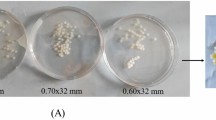Abstract
Alkaline protease from Conidiobolus macrosporus was immobilized on polyamide using glutaraldehyde as a bifunctional agent. The immobilized enzyme was optimally active at a higher temperature of 50 °C than the free enzyme (40 °C ) and showed a ten-fold increased thermostability at 60 °C compared to that of the free enzyme. The efficiency of immobilization was 58% under the optimal conditions of pH and temperature. There was a 14-fold decrease in the K m of immobilized enzyme compared to the free enzyme. The immobilized enzyme was fully active even after twenty-two cycles of repeated use. It retained 80% activity at 50 °C in presence of 8 M urea exhibiting its stability to the denaturant and was compatible with several commercial detergents.
Similar content being viewed by others
References
Braxton S, Wells J (1992) Incorporation of a stabilizing Ca2Cbinding loop into subtilisin BPN′. Biochemistry 31: 7796–7801.
Chellapandian M, Velan M (1998) Epichlorohydrin activated cellulose beads for the immobilization of alkaline protease. Acta Aliment. 27: 13–20.
Imanaka T, Shibazaki M, Takagi M (1986) A new way of enhancing the thermostability of proteases. Nature 324: 696–697.
Kunitz M (1947) Crystalline soybean trypsin inhibitor II. General properties. J. Gen. Physiol. 30: 291–310.
Perry J, Wetzel R (1984) Disulfide bond engineered into T4 lysozyme: stabilization of the protein towards thermal inactivation. Science 226: 555–557.
Phadatare S, Deshpande V, Srinivasan M (1993) High activity alkaline protease from Conidiobolus coronatus (NCL 86.8.20): enzyme production and compatibility with commercial detergents. Enzyme Microbiol. Technol. 15: 72–76.
Rao M, Tanksale A, Ghatge M, Deshpande V (1998) Molecular and biotechnological aspects of microbial proteases. Microbiol. Mol. Biol. Rev. 62: 597–635.
Tanksale A, Vernekar J, Ghatge M, Deshpande V (2000) Evidence for the presence of tryptophan in the active site of an alkaline protease and its proximity with essential histidine and cysteine residues. Biochem. Biophys. Res. Commun. 270: 910–917.
Zaborsky O (1973) Introduction. In: Weast RC, ed. Immobilized Enzymes. Ohio: CRC Press, pp. 1–2.
Author information
Authors and Affiliations
Rights and permissions
About this article
Cite this article
Tanksale, A., Chandra, P.M., Rao, M. et al. Immobilization of alkaline protease from Conidiobolus macrosporus for reuse and improved thermal stability. Biotechnology Letters 23, 51–54 (2001). https://doi.org/10.1023/A:1026782206945
Issue Date:
DOI: https://doi.org/10.1023/A:1026782206945




